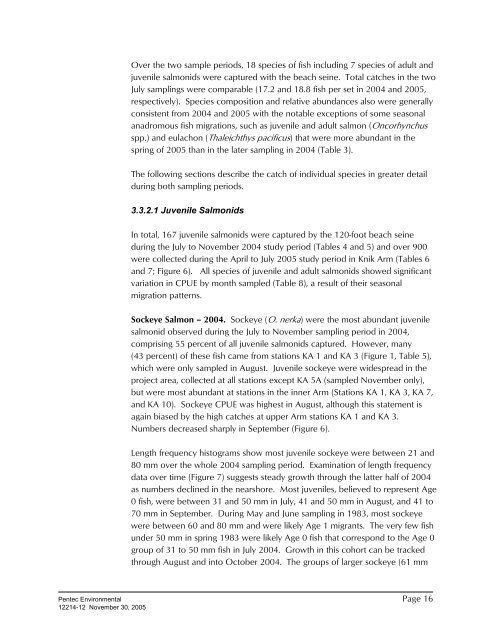Marine Fish and Benthos Studies - Knik Arm Bridge and Toll Authority
Marine Fish and Benthos Studies - Knik Arm Bridge and Toll Authority
Marine Fish and Benthos Studies - Knik Arm Bridge and Toll Authority
You also want an ePaper? Increase the reach of your titles
YUMPU automatically turns print PDFs into web optimized ePapers that Google loves.
Over the two sample periods, 18 species of fish including 7 species of adult <strong>and</strong><br />
juvenile salmonids were captured with the beach seine. Total catches in the two<br />
July samplings were comparable (17.2 <strong>and</strong> 18.8 fish per set in 2004 <strong>and</strong> 2005,<br />
respectively). Species composition <strong>and</strong> relative abundances also were generally<br />
consistent from 2004 <strong>and</strong> 2005 with the notable exceptions of some seasonal<br />
anadromous fish migrations, such as juvenile <strong>and</strong> adult salmon (Oncorhynchus<br />
spp.) <strong>and</strong> eulachon (Thaleichthys pacificus) that were more abundant in the<br />
spring of 2005 than in the later sampling in 2004 (Table 3).<br />
The following sections describe the catch of individual species in greater detail<br />
during both sampling periods.<br />
3.3.2.1 Juvenile Salmonids<br />
In total, 167 juvenile salmonids were captured by the 120-foot beach seine<br />
during the July to November 2004 study period (Tables 4 <strong>and</strong> 5) <strong>and</strong> over 900<br />
were collected during the April to July 2005 study period in <strong>Knik</strong> <strong>Arm</strong> (Tables 6<br />
<strong>and</strong> 7; Figure 6). All species of juvenile <strong>and</strong> adult salmonids showed significant<br />
variation in CPUE by month sampled (Table 8), a result of their seasonal<br />
migration patterns.<br />
Sockeye Salmon – 2004. Sockeye (O. nerka) were the most abundant juvenile<br />
salmonid observed during the July to November sampling period in 2004,<br />
comprising 55 percent of all juvenile salmonids captured. However, many<br />
(43 percent) of these fish came from stations KA 1 <strong>and</strong> KA 3 (Figure 1, Table 5),<br />
which were only sampled in August. Juvenile sockeye were widespread in the<br />
project area, collected at all stations except KA 5A (sampled November only),<br />
but were most abundant at stations in the inner <strong>Arm</strong> (Stations KA 1, KA 3, KA 7,<br />
<strong>and</strong> KA 10). Sockeye CPUE was highest in August, although this statement is<br />
again biased by the high catches at upper <strong>Arm</strong> stations KA 1 <strong>and</strong> KA 3.<br />
Numbers decreased sharply in September (Figure 6).<br />
Length frequency histograms show most juvenile sockeye were between 21 <strong>and</strong><br />
80 mm over the whole 2004 sampling period. Examination of length frequency<br />
data over time (Figure 7) suggests steady growth through the latter half of 2004<br />
as numbers declined in the nearshore. Most juveniles, believed to represent Age<br />
0 fish, were between 31 <strong>and</strong> 50 mm in July, 41 <strong>and</strong> 50 mm in August, <strong>and</strong> 41 to<br />
70 mm in September. During May <strong>and</strong> June sampling in 1983, most sockeye<br />
were between 60 <strong>and</strong> 80 mm <strong>and</strong> were likely Age 1 migrants. The very few fish<br />
under 50 mm in spring 1983 were likely Age 0 fish that correspond to the Age 0<br />
group of 31 to 50 mm fish in July 2004. Growth in this cohort can be tracked<br />
through August <strong>and</strong> into October 2004. The groups of larger sockeye (61 mm<br />
Pentec Environmental Page 16<br />
12214-12 November 30, 2005
















